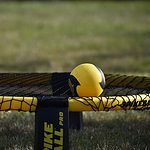Much like the storied battles of ancient Rome, where strategy and teamwork ruled the arena, the game of Ultimate Frisbee requires a cunning mix of precision and wit. You're stepping onto a field that measures 70 by 40 yards, armed with a team of seven, each player pivotal to your success. The match kicks off with a pull, setting the tone for a session governed by swift passes and strategic plays within a ten-second count. But what happens when the disc touches the ground, or a pass flies out of bounds? Stick around, because understanding these infractions could very well change your game.
Field Dimensions and Layout

The official Ultimate Frisbee field is a rectangular 70 yards by 40 yards area, including 20-yard deep end zones at each end. This configuration adheres strictly to the game's rules, guaranteeing a standardized play area worldwide. The field's dimensions, especially smaller than a football field, demand precise throws and strategic gameplay.
The layout is clearly marked to avoid confusion during play. Cones are placed at each of the four corners, defining the boundary lines and making it visually easier for you to determine in-bounds and out-of-bounds areas. These boundary lines, including those marking the end zones, are integral parts of the game field. Any disc that lands on the lines is considered in play.
Understanding these dimensions and layout is important for proper game setup and for making strategic decisions during play. Whether you're setting up a field or participating in a game, knowing the exact field specifications ensures that the game is played fairly and according to official standards. Remember, the precise arrangement of boundary lines and cones not only guides gameplay but also affects your team's defensive and offensive tactics. Make sure you're familiar with these details to enhance your understanding and performance in the game.
Team Composition and Substitutions
After grasping the field's layout, it's important to understand that each Ultimate Frisbee team plays with 7 members on the field. This includes both men and women, highlighting the sport's inclusive nature. You'll see that teams can have an unlimited number of players on their roster, allowing flexible strategies and fresh legs to maintain the game's fast pace.
Substitutions, however, follow specific rules. Unlike some sports where players may switch in and out freely during gameplay, in outdoor Ultimate Frisbee, you're only allowed to substitute players between points. This means once the point starts, those seven players are the only ones participating until the next point begins. This rule tests your team's endurance and strategic planning, as you must decide when it's best to rotate players to maximize effectiveness and stamina.
If you're playing indoor Ultimate Frisbee, the dynamics shift slightly. Here, substitutions can occur 'on the fly,' meaning players can switch in and out more fluidly during play. This variation accommodates the typically faster pace and smaller playing area of indoor environments, requiring you to adapt your substitution strategy to maintain a competitive edge throughout the game.
Starting the Game: Pull

Now that you understand how a game of Ultimate Frisbee begins with the pull, let's examine the mechanics behind this vital throw and the strategies you can employ immediately afterwards.
You'll need to master both the technique of executing a strong, accurate pull and the tactical decisions that follow to effectively set your team up for defensive success.
Pull Mechanics Explained
Initiating an Ultimate Frisbee game, the defending team executes the pull by throwing the disc from their end zone to the offensive team. This act not only starts the play but also determines how the game's momentum begins.
The pull must be launched within 7 seconds after the offensive team signals they're ready. This timing is important as it keeps the game flowing and fair.
The quality of the pull can greatly influence the initial setup of the game, setting a tone for the defending team's strategy. It's essential you understand that the pull isn't just a formality; it's a tactical play that can shape the early dynamics of the match, giving the offensive team the first opportunity to organize and attack.
Strategy After Pull
Following the pull, the receiving team takes on the role of offense and immediately begins strategizing to advance the disc toward the opposing end zone. As the defense immediately takes possession of their roles, you're thrust into the first critical moment of the game. Your strategy here can determine the pace and tone for the rest of the match.
| Aspect | Focus |
|---|---|
| Offense | Advance disc to end zone |
| Defense | Force turnover |
| Player | Execute strategy |
| Thrower | Key disc handler |
| End Zone | Ultimate scoring target |
Effective communication and quick decision-making are essential. Each player must be alert, ready to adapt, and execute their role flawlessly to either score or disrupt the flow and regain control.
Scoring System Explained
To score in Ultimate Frisbee, a team must successfully catch a pass in the opponent's end zone. Each completed catch that results in firm possession of the disc within the boundaries of the end zone scores one point. It's important that both of the player's feet are inbounds.
Once a goal is scored, teams switch directions for the next play, starting with a pull from the scoring team. This cycle encourages continuous action and strategic play.
Here's a quick rundown of what you need to know about scoring:
- Completion and Possession: You mustn't only catch the disc but also demonstrate control over it within the end zone. Juggling or bobbling before establishing possession could invalidate a would-be goal.
- Inbounds Requirement: Make sure both your feet are inside the end zone when you make the catch. Stepping out before securing the disc means no point.
- Reset After Scoring: After a goal, prepare to switch sides as the game resets with a pull from the team that just scored. This keeps the game dynamic and tests team adaptability.
Understanding these rules will help you appreciate the scoring nuances in Ultimate Frisbee and enhance your enjoyment of the game.
Rules for Passing the Disc

After understanding how scoring works, let's look at how players pass the disc in Ultimate Frisbee. Once you've gained possession of the disc, you've got ten seconds to throw it to a teammate. This rule keeps the game moving swiftly and strategically. Remember, you can't run with the disc. To advance toward the opposing end zone, you must pass the disc.
Establishing a pivot foot is essential once you have the disc. This foot must remain stationary until the disc has left your hand. You're free to pass the disc in any direction to a teammate downfield, allowing for dynamic play and strategic positioning.
Be mindful, however, that incomplete passes result in turnovers, changing possession immediately. This rule emphasizes the importance of accurate throws and well-coordinated team movements. Each pass you make is crucial, as losing possession can shift the momentum of the game. Therefore, precision and teamwork are key to maintaining control of the disc and effectively advancing towards scoring. In essence, mastering the art of passing under these constraints is essential for success in Ultimate Frisbee.
Turnovers and Their Causes
Understanding turnovers in Ultimate Frisbee is essential, as they can greatly impact the game's outcome. A turnover happens when a pass is incomplete or intercepted, leading to a change in possession. This shift can turn the tide of a match, making it vital for you to grasp the common causes and play strategically.
Here are the primary reasons turnovers occur:
- Handling Errors: These include drops and throwaways, where the disc isn't properly caught or is inaccurately thrown.
- Defensive Actions: Blocks by defenders or interceptions can unexpectedly shift control of the disc.
- Rule Violations: Stalls, travel violations, or picks disrupt the flow and can lead to turnovers.
Familiarizing yourself with these causes helps prevent unnecessary turnovers and encourages efficient gameplay. You'll also need to be aware of other violations like double teaming, fast count, or disc space issues, which can further complicate possession.
Fouls and Contact Regulations

When you're playing Ultimate Frisbee, understanding what constitutes a foul is essential.
A foul involves non-incidental contact that disrupts the play, and you'll need to resolve it through discussion or replay the point if there's disagreement.
Defining a Foul
In Ultimate Frisbee, a foul occurs through non-incidental contact between players that disrupts the game. Here's how you handle these situations:
- Immediate Resolution: You must discuss the foul with the involved players. Agreement on the outcome is essential and should be reached promptly.
- Acknowledgment: If you're the player who committed the foul, you need to acknowledge it. The affected player then decides the resolution, ensuring fair play continues.
- Significance of Infractions: Make foul calls only for significant infractions that impact the game. This maintains the integrity and the Spirit of the Game.
Always approach foul resolution in the spirit of fairness, upholding the Spirit of the Game which prioritizes respect among players and honest, objective judgment.
Contact Rules Clarified
Fouls in Ultimate Frisbee, marked by non-incidental contact, require players to halt gameplay and seek immediate resolution. When you're involved in or witness such a foul, you must stop play right away and address the situation.
The player who committed the foul needs to acknowledge it, and the affected player has the right to contest if necessary. If the foul has influenced the play's outcome, the game will revert to the last uncontested possession. This safeguards fairness and maintains the spirit of the game.
Understanding these contact regulations is vital, as they help keep the gameplay fair and respectful. Always remember, resolving fouls promptly and fairly is key to the integrity of the game.
Self-Officiating and Spirit of the Game
Ultimate Frisbee relies on players to self-officiate, ensuring the game is played with integrity and respect. This unique aspect of Ultimate Frisbee not only keeps the game flowing but also instills a deep sense of responsibility and honesty among players. You're expected to make calls on fouls and violations, fostering an environment where fair play and mutual respect are paramount.
The Spirit of the Game is central to how Ultimate Frisbee is played. It goes beyond the basic rules, emphasizing sportsmanship and respect. Here's what you need to know about self-officiating and the Spirit of the Game:
- Fair Play: Players are responsible for making honest calls and are encouraged to admit their own infractions.
- Mutual Respect: Disputes should be resolved amicably through discussion and mutual agreement, maintaining respect for all players involved.
- Open Communication: Effective communication is essential. Players discuss and resolve disagreements with a focus on what's fair rather than who's right.
Time Limits and Game Duration

Understanding the time limits and game duration is vital for strategizing and maintaining pace in Ultimate Frisbee. A regulation game typically lasts about 100 minutes, but this can vary depending on the level of play and specific situations. Games are generally played until one of the teams reaches a goal total, often set at 15.
Time limits are essential as they dictate how you manage your team's energy and plays. The game employs both soft and hard cap rules to enforce time limits effectively. A soft cap extends the game until the current scoring attempt is completed, allowing play to continue briefly beyond the initial time limit. In contrast, a hard cap concludes the game after a predetermined time, regardless of the score, ensuring the game doesn't extend too far beyond the planned duration.
Here's a quick reference for how time affects gameplay:
| Aspect | Description |
|---|---|
| Goal Total | Usually 15 |
| Regulation Time | ~100 minutes |
| Soft Cap | Extends game until current point ends |
| Hard Cap | Ends game at a set time |
| Timeouts | Suspend time limits; strategic pauses |
Managing these time limits effectively can be the key to securing a win, so keep your eyes on the clock and adjust your strategies accordingly.
End Zone Rules
To score in Ultimate Frisbee, you must catch the disc in the opponent's end zone. If you catch the frisbee, make sure both feet are in bounds; otherwise, the point won't count.
Each goal leads to a switch in field direction, and the scoring team throws the next pull to restart the game.
Scoring a Goal
How do you score a goal in Ultimate Frisbee? Simply catch a pass in the opposing team's end zone while keeping both feet in bounds. Here's what you need to know about securing that important point:
- Catch the Pass: Make sure you have firm possession of the disc by catching it with both feet clearly in bounds within the end zone.
- Establishing Position: If one foot lands out of bounds during the catch, it's not a valid score.
- Resuming Play: After scoring a goal, your team earns a point, and play resumes with a new pull, switching directions.
Incomplete Pass Consequences
While scoring a goal in Ultimate Frisbee revolves around successful catches in the end zone, failing to complete a pass there results in immediate turnover and a shift in possession.
Whenever your throw leads to an incomplete pass—whether it's dropped, intercepted, or sails out of bounds—you're handing over the opportunity to score to your opponents. This loss of possession underscores the necessity of executing accurate passes during critical moments. Mastery of this aspect is key to strategic gameplay in Ultimate Frisbee.
Disc Movement Restrictions

In Ultimate Frisbee, players must pass the disc to advance it, as running with the disc is prohibited. You're restricted to passing the disc within a tight set of rules designed to maintain the game's fast pace and strategic nature.
Here are critical points on disc movement restrictions:
- 10-Second Rule: As the disc (thrower) has ten seconds to pass the disc, a marker (another player) starts a stall count as soon as they're within marking distance. If the thrower doesn't release the disc before the count reaches ten, the possession changes hands.
- Pass Completion: If a pass isn't completed — that is, if the disc is dropped, intercepted, or goes out of bounds — possession immediately switches to the opposing team. Keeping possession is vital, as turnovers can quickly shift the momentum of the game.
- Non-contact: While jostling for position is common, if a player initiates contact to gain an advantage or disrupt play, penalties can be enforced. It's essential to play with respect for the physical safety and competitive spirit of the game.
Special Competition Adjustments
Special competition adjustments allow captains to negotiate rule variations for games that aren't governed by the standard event organizer's rules. You'll find that in special competitions or unique tournament formats, specific rules tailored to the situation at hand often override general regulations. This guarantees the game adapts to particular needs or challenges posed by the event.
Appendices in the official rulebook outline these rules changes and additions, providing a structured way to understand the modifications applicable to different variations of Ultimate Frisbee. As a player or a captain, you're expected to familiarize yourself with these appendices. They serve as a guide for what might be altered in the usual play rules during special tournaments or events.
It's important that all agreed-upon rules modifications are clearly understood and adhered to by everyone involved. These competition modifications ensure fairness and maintain the spirit of the game, even when traditional rules are adjusted. Remember, the integrity of the game relies on each player's commitment to these agreed-upon rules. By staying informed and respectful of these adjustments, you contribute to a competitive yet fair atmosphere where the spirit of Ultimate Frisbee thrives, regardless of the specific competition scenario.
Conclusion
As you immerse yourself into Ultimate Frisbee, remember it's not just about throwing a disc but playing your cards right on a 70 by 40-yard field.
With teams of seven, each player must be quick on their feet and sharp with their strategies.
From the initial pull to scoring in the end zone, every pass counts, and the clock's ticking with each ten-second interval.
Master these rules, and you'll not only play the game, you'll own the field.





